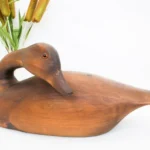
Open Daily 10am - 5pm
12,000sq.ft. of amazing items!
Free and easy parking!

A number of colorful folks attended the recent mini-Modernism Show and quite a few interesting conversations were had. Among the most thought-provoking was a rather depressing thesis put forth by the long-time publisher of an antique collectors magazine. He foresees the end of collecting as a widespread pastime by the middle of this century. While that seems rather extreme, his well-reasoned musings are worth reviewing below.
The argument goes like this. Up until the end of WWII, America’s emerging middle class had been shaken by depression and then war. Home ownership was relatively limited and the houses much smaller on average than those of today. Disposable income was limited and didn’t go far. It was all most homeowners could do to hold onto what they had.
Prior to that time, antique collecting was largely the purview of the well-to-do. They had the means, the time, the education, and the interest to pursue pastimes beyond those simply required to make a living. In many parts of Europe, antiques were available for a pittance during much of the first half of the 20th century, and the well-traveled American elite could and did buy with both hands. Vast collections were assembled and brought to the New World, many of which became the foundations of great domestic museums. It was a heady time to collect but limited to the very few.
With war’s end came a booming economy that elevated the financial condition of millions of Americans. Jobs were plentiful, home ownership was within reach, and today’s consumerism revved into gear. During their overseas tours, many GIs had been exposed to historic lands and artifacts for the first time, piquing their interest in the wider world. And upon returning home, and thanks to the GI Bill, millions of servicemen received an education far in advance of their parents and grandparents. It was a time for new directions.
As one result, interest in antiques and collecting grew slowly but surely following war’s end. By the 1990s, the antiques and collectibles market was booming. An industry of “limited editions” grew from nothing, and categories like ceramics, lithographs, medallions and statuary were available everywhere. Those were salad days. Of course, too much of a good thing is still too much, and over-production of collectibles eventually saturated the market. How many knick-knacks does one need?
Today the market for such items has softened considerably and according to our publisher friend may go away entirely over the next 30 or so years. The middle class is strapped like never before and millennials have little interest in spending money on anything beyond experiences and technology. Home ownership seems to be decreasing in popularity, making collecting a burdensome hobby. Moreover, there is little of permanent value being made today. The craftsmanship and skilled labor of yore have disappeared as consumers have embraced disposability in all things. Will the young people of today really want to collect iPhones in years to come?
Our publisher’s conclusion is that 2050 will look much like 1940 in terms of antiques. The well-heeled will continue to collect, driving up prices of premium items in categories that will cycle hot and cold. Those mid-range collectors that remain will focus on smaller items to accommodate their smaller environments, continuing to ignore craftsmanship in favor of wizardry and pop culture. And the makers of collectible items, already bruised and battered, will all but disappear. In short, it’s a buyer’s market and will remain so for some time to come.
If all this seems a bit too draconian to you, it does to me as well. Nonetheless, it does reinforce two long-standing tenants of collecting: buy what you like and don’t try to out-guess the market. To succeed in that, your crystal ball will have to be much better than mine, and certainly that of our friend the publisher.





We’ll email you about the latest events, sales, and general store updates.

Our antique gallery is located just south of downtown Palm Springs, with free parking and air conditioning throughout.
Open Daily: 10am – 5pm
505 E Industrial Pl.
Palm Springs, CA 92264
© Copyright Antique Galleries of Palm Springs 2024